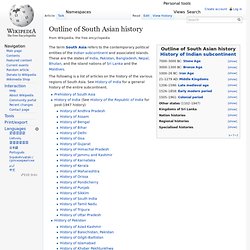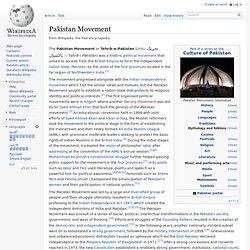

Outline of Pakistan. The following outline is provided as an overview of and topical guide to Pakistan: The Islamic Republic of Pakistan is a sovereign country located in South-central Asia.[1][2][3] It has a 1,046-kilometer (650 mi) coastline along the Arabian Sea and Gulf of Oman in the south, and is bordered by Afghanistan and Iran in the west, India in the east and China in the far northeast.[4][5] General reference[edit] Geography of Pakistan[edit] An enlargeable topographic map of Pakistan India (including the disputed LoC is 2,912 km) Afghanistan 2,430 km Iran 909 km China 523 km Coastline: Arabian Sea 1,046 km.

Etymology of Pakistan. Outline of South Asian history. Outline of South Asian history From Wikipedia, the free encyclopedia Jump to: navigation, search.

History of Pakistan. Self-appointing himself as President after the resignation of President Rafiq Tarar, Musharraf held nation-wide general elections in 2002 to transfer the executive powers to newly elected Prime Minister Zafarullah Khan Jamali, who was succeeded in the 2004 by Shaukat Aziz.

During the election campaign in 2007 following the parliament completing its term on 15 November 2007, Benazir Bhutto was assassinated which resulted in a series of important political developments when left-wing alliance led by PPP. The historic general elections held in 2013 marked the return of PML(N) coming to national prominence with Prime Minister Nawaz Sharif assuming the leadership of the country for the third time in the history. Prehistory[edit] Soanian Culture[edit] The Soanian is an archaeological culture of the Lower Paleolithic (ca. 1.9 mya to 125,000 BC), contemporary to the Acheulean. Mehrgarh period[edit] Indus Valley Civilization[edit] Early history[edit] Vedic period[edit] Archaeological cultures.
History of Pakistan: Early and Middle ages. History of Pakistan: Colonial period. Partition of India. The British Indian Empire in the end of the British period 1947, except Nepal and Bhutan which were independent kingdoms Maps of India and Pakistan shown in October 1947, after the partition The secession of Bangladesh from Pakistan in 1971 is not covered by the term Partition of India, nor is the earlier separation of Burma (now Myanmar) from the administration of British India, or the even earlier separation of Ceylon (now Sri Lanka).

Ceylon was part of the Madras Presidency of British India from 1795 until 1798 when it became a separate Crown Colony of the Empire. Burma, gradually annexed by the British during 1826–86 and governed as a part of the British Indian administration until 1937, was directly administered thereafter.[2] Burma was granted independence on 4 January 1948 and Ceylon on 4 February 1948. British Raj. The British Raj (rāj, lit.

"rule" in Hindi)[2] was the British rule in the Indian subcontinent between 1858 and 1947.[3] The term can also refer to the period of dominion.[3][4] The region under British control—commonly called "India" in contemporary usage—included areas directly administered by the United Kingdom[5] (contemporaneously, "British India") as well as the princely states ruled by individual rulers under the paramountcy of the British Crown. The region was less commonly also called the Indian Empire.[6] As India, it was a founding member of the League of Nations, a participating nation in the Summer Olympics in 1900, 1920, 1928, 1932, and 1936, and a founding member of the United Nations in San Francisco in 1945.[7] Geographical extent[edit] The British Raj extended over almost all present-day India, Pakistan, and Bangladesh, with exceptions such as Goa and Pondicherry.
Pakistan Movement. History of the movement[edit] Background[edit] In all over the subcontinent, the British government took over the state machinery, bureaucracy, universities, schools, and institutions as well establishing its own.[22] During this time, Lord Macaulay radical and influential educational reforms led to the numerous changes to the introduction and teaching of Western languages (e.g.

English and Latin), history, and philosophy.[23][24] Religious studies, Arabic, Turkish, and Persian languages were completely barred from the state universities. In a short span of time, the English language had became not only the medium of instruction but also the official language in 1835 in place of Persian, disadvantaging those who had built their careers around the latter language.[24] In justifying these actions, Macaulay's notably argument that Sanskrit and Arabic were wholly inadequate for students studying history, science and technology. History of Pakistan: Independance. Monarchy of Pakistan.